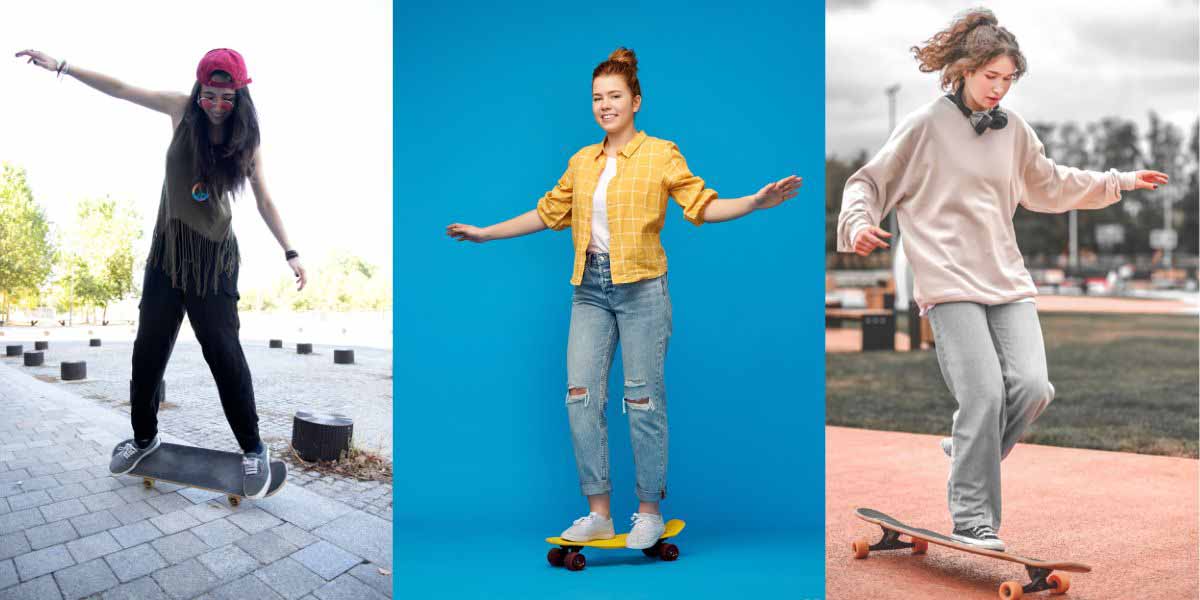To balance on a skateboard, place your feet shoulder-width apart and keep your knees slightly bent. Focus on maintaining a low center of gravity.
Learning how to balance on a skateboard is the first step to mastering the sport. For many beginners, it’s normal to struggle at first, but with the right techniques, you can improve your balance quickly.
This guide will help you understand how to balance on a skateboard for beginners, avoid common mistakes, and build confidence. Let’s dive in!
The Basics of Standing on a Skateboard
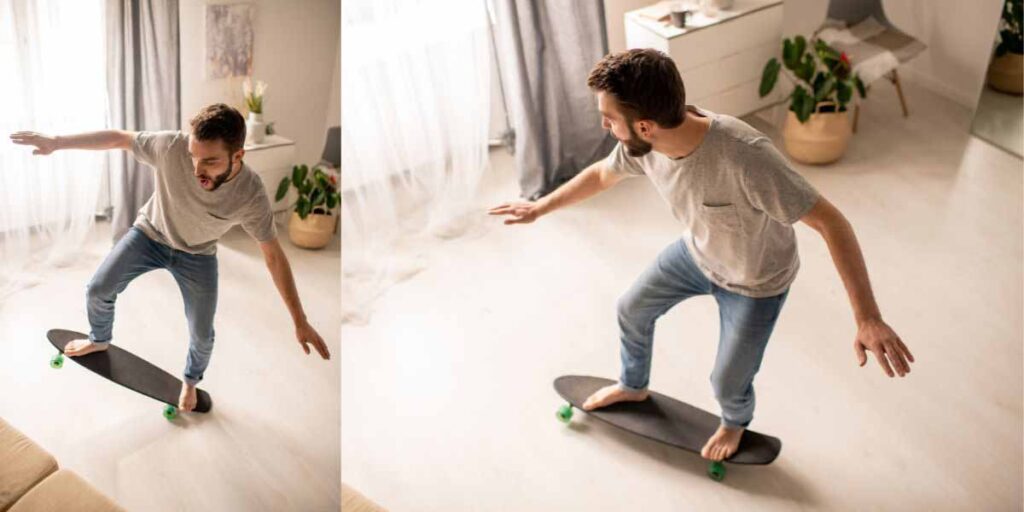
Before you begin moving on a skateboard, it’s important to learn how to stand correctly. The way you stand (also known as your stance) is the foundation of good balance. Most skaters use one of two stances: regular (left foot forward) or goofy (right foot forward). To find yours, stand naturally on the board without overthinking it. Your dominant foot usually feels more comfortable at the back.
The first time you step on a skateboard, place it on a stable surface, like grass or carpet, to prevent it from rolling. Set your front foot just behind the front bolts at a slight angle, and place your back foot near the back bolts, shoulder-width apart. Slightly bend your knees to keep your center of gravity low, which helps in maintaining stability.
Pro Tip: Always keep your shoulders parallel to your feet and your eyes looking straight ahead, not down at the board. This will help you avoid sudden wobbles and maintain balance.
Choosing the Right Skateboard for Better Balance
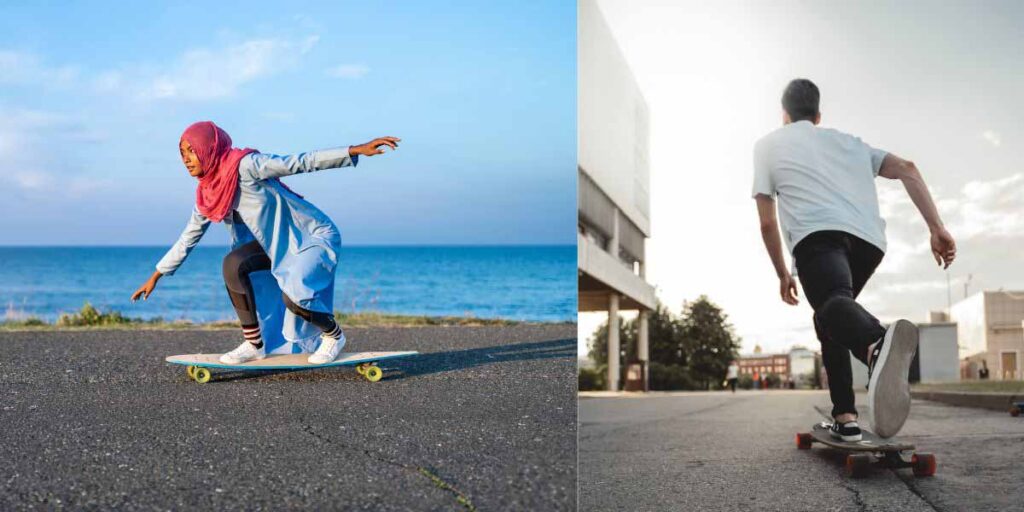
The type of skateboard you use can make a big difference in your ability to balance. Beginners should start with a wider board, as it provides more stability. The deck, wheels, and trucks all affect how stable your board feels.
- Deck Width: A wider deck (8-8.5 inches) is easier to balance for beginners.
- Wheels: Softer wheels offer more grip, making it easier to stay balanced, especially on rough surfaces.
- Trucks: Tighten your trucks to reduce wobbles when you’re just starting out.
Avoid boards that are too narrow or have wheels that are too hard, as they can make balancing harder. It’s also important to choose the right skateboard size for better skating.
Step-by-Step Guide on How to Stand and Balance on a Skateboard Without Falling
Standing on a skateboard without falling may seem daunting, but breaking it down into manageable steps can make the process easier. Here’s how you can master this basic yet crucial skill:
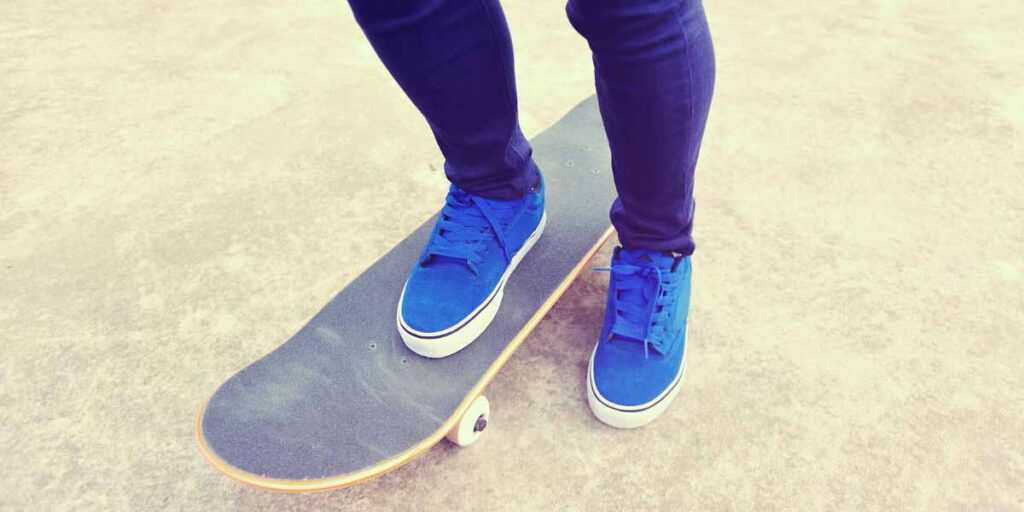
1. Position Your Front Foot
Start by placing your front foot on the board, just behind the front bolts, angled slightly forward. This position gives you control and sets the foundation for your balance.
2. Bring Your Back Foot Up Slowly
With your front foot steady, slowly lift your back foot and place it near the back bolts. Keep your feet shoulder-width apart for maximum stability.
3. Bend Your Knees Slightly
Keep your knees relaxed and slightly bent. This posture lowers your center of gravity, giving you more control over the skateboard and helping you absorb small bumps or shifts in balance.
4. Distribute Your Weight Evenly
Shift your weight evenly between both feet. Avoid leaning too far forward or backward, as this can cause you to lose balance. The goal is to keep your weight centered over the board.
5. Look Forward, Not Down
Keep your eyes focused on where you want to go, not on your feet. This helps maintain a steady posture and balance, allowing you to respond better to movement.
When you first start, your feet may feel unsteady. Practice this positioning repeatedly on a stationary surface until it feels comfortable and natural.
Common Mistakes Beginners Make While Balancing
Even small mistakes can affect your balance. Here are some common errors beginners make and how to fix them:
- Stiffness makes it hard to adjust your balance. Keep your knees bent and your movements smooth.
- Leaning forward or backward too much can cause you to lose control. Stay centered over the board.
- Your body tends to follow where you look. Always keep your eyes ahead to maintain proper balance.
Recognizing and correcting these mistakes early will set you up for faster improvement.
Practicing Balance on Different Surfaces
Learning to balance on a skateboard becomes much easier when you start on the right surfaces. The type of ground you practice on can significantly impact your progress.
To begin with, practicing on grass or carpet is ideal for beginners. These surfaces slow down the wheels, allowing you to focus on balancing without worrying about rolling away.
Once you feel comfortable standing still, you can move on to a smooth, flat pavement. This transition helps you get used to the sensation of a moving board while still keeping your balance manageable.
Remember to spend ample time on each surface, gradually increasing the difficulty as you build confidence. By progressing step-by-step, you’ll develop better balance and control on your skateboard.
Tips for Maintaining Balance While Riding
Once you’re comfortable standing, you can start moving. Here are tips to help maintain your balance while riding:
Shift Your Weight Gradually: When you start rolling, make small weight shifts to steer and balance.
Practice Turning: Use your heels and toes to shift your weight and turn the board. Don’t over-lean; keep movements gentle.
Stay Loose: Keep your body flexible. Don’t lock your knees or elbows.
Regularly practicing these movements helps your body get used to the motions, making balancing second nature.
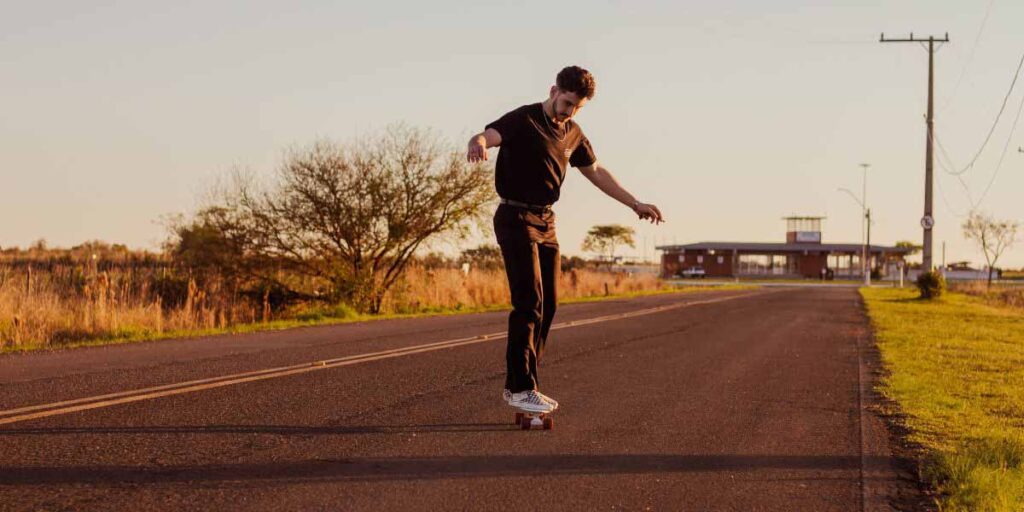
Improving Your Balance with Core Exercises
A strong core helps you maintain balance on your skateboard. Adding a few simple exercises to your routine can boost your stability:
- Hold a plank for 20-30 seconds to strengthen your core muscles.
- Squats improve your leg strength and help with balance.
- Stand on one foot or use a balance board to enhance your coordination.
These exercises train your body to respond quickly and maintain balance.
Overcoming Fear and Building Confidence
Many beginners struggle with the fear of falling. This fear can make you stiffen up, which actually makes balancing harder. Here’s how to overcome it:
Don’t rush into fast movements. Begin with standing and slow rolls before trying anything advanced.
Wearing helmets, knee pads, and wrist guards can give you the confidence to practice without worrying about injuries.
Focus on mastering one skill at a time, like just standing still, then progressing to slow rides.
As you build confidence, your balance will improve, and skateboarding will start to feel natural.
Why Can’t I Keep My Balance on a Skateboard?
Balancing on a skateboard can be tricky for beginners. There are several reasons why you might struggle to keep your balance.
One common issue is an incorrect stance—standing with your feet too close together or placing them in the wrong positions can throw off your balance. Make sure your front foot is behind the front bolts, slightly angled, and your back foot is near the back bolts, with knees slightly bent to lower your center of gravity.
Another reason could be a weak core; your core muscles play a crucial role in maintaining stability, so incorporating exercises like planks and squats can help strengthen this area.
Additionally, many beginners tend to stiffen their legs, making it harder to adjust to movements on the board. Keeping your knees relaxed and flexible allows you to respond better to the skateboard’s movements.
Fear of falling is also a big factor—this anxiety can make you tense, leading to shaky or unsteady balance. Wearing protective gear like helmets and pads can help you feel more secure.
Finally, remember that balance improves with practice. The more time you spend on the board, the more your body will adapt. As a result, it helps you keep your balance better over time.
Safety Tips for Beginners
Safety is crucial when learning to skateboard. Here are some tips:
- Wear protective gear like helmets, knee pads, and wrist guards to protect yourself from falls.
- Learn how to fall safely by rolling out of a fall instead of catching yourself with your hands.
- Practice in a safe area with smooth, flat ground, and avoid crowded places while you’re learning.
FAQs
How long does it take to learn to balance on a skateboard?
Most beginners can learn the basics of balancing within a few days of regular practice.
Is balancing on a skateboard hard for beginners?
It can be challenging initially, but with proper guidance and practice, balancing becomes easier over time.
What stance should I use on a skateboard?
Most beginners use the regular stance, with the left foot forward. Some prefer the goofy stance, with the right foot forward. Choose the stance that feels more comfortable.
How can I improve my skateboard balance?
Improving balance on a skateboard involves regular practice. Use balance boards or practice on grass or carpet. Maintain a low center of gravity by bending your knees.
Is it normal to fall when learning to skateboard?
Yes, falling is a normal part of learning to skateboard. Always wear protective gear like helmets and pads.
Conclusion
Balancing on a skateboard is a fundamental skill that opens the door to all other skateboarding tricks and techniques. With consistent practice, proper stance, and patience, you’ll find yourself balancing confidently in no time. Focus on mastering the basics, avoid common mistakes, and remember that progress takes time. Keep practicing, stay safe, and enjoy the ride!

